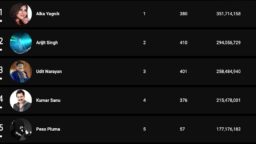The following MBW feature comes from Amit Gurbaxani (pictured inset), a freelance music journalist based in India and an expert on the modern evolution of the country’s music industry.

India is home to the largest number of viewers of YouTube in the world. The video streaming service’s reported base of over 450 million monthly active users in the country dwarfs the nation’s customers on audio OTTs, which all together are around 200 million.
This, arguably, makes YouTube the platform that provides the best representation of pan-India popularity. Its weekly charts, then, are a snapshot of the music Indians are listening to the most.
Except, tracking Indian music videos has proved particularly problematic for YouTube.
Shortly after they launched charts for India in September 2019 – almost a year and a half after debuting them in over 40 other countries – I interviewed Chris Clark, product manager at Google, about the challenges of putting charts together for a country with an exceptionally diverse and dynamic domestic music industry.
While it’s often mistakenly seen as limited to Bollywood, in reality, Hindi film songs’ share of overall listenership has been steadily decreasing over the last half-decade and while that of commercial Hindi pop and music in other regional Indian languages has been rising.
This was something Clark and his team was mindful of even three years ago.
“The more we dug into the Indian music market, the more I learnt about regional music and different language music and how there was a chance that Bollywood would dominate,” he said.
“So we postponed the charts’ launch because we wanted to do a more bespoke version that included regional and language variations.”
So far, YouTube has been relatively successful in covering India’s varied consumer base. But there are other challenges that have proved harder to surmount – such as making sure all music videos are accounted for while tallying up the charts, and, somewhat unusually, that they aren’t subsequently removed from the platform.
“We rely on music labels and artists to claim things and help us with sound recordings,” Clark said at the time. “We do our best to corral quite literally all music content, even if it’s from a small label.”
Their biggest miss so far seems to be the lyric video “Arabic Kuthu” from the Tamil-language movie Beast.
The tune went viral and reached the top five of most audio-streaming services’ all-genre charts, including the Spotify India Top 200, Apple Music India Daily Top 100, and local DSP Wynk Music’s Top 100. But despite racking up more than 400 million views on YouTube since hitting the service in Q1, it was conspicuous by its absence on their Top Music Videos chart for India.
When I noticed this in February, I asked around, and was told by some industry experts that the likeliest explanation was that because the video is published on the channel of a film production company, Sun TV (the makers of Beast) YouTube’s chart tracking system did not pick it up.
I subsequently emailed Google’s press team in India in early June, and while I received a fairly generic response, later that week “Arabic Kuthu” – nearly four months after its release – finally entered the YouTube India Top Music Videos.
“YouTube hosts a lot of non-music content and needs ways to filter that content off the music chart if said content is non-music,” said a Google spokesperson in response to the questionnaire sent by Music Business Worldwide.
“Our charts are built on both algorithm-driven classification engines and human reviewers. With more than 500 hours of content uploaded to YouTube every minute across the world, there may be rare instances where a video for a song may be classified incorrectly (i.e. miss content that should be included or content mistakenly included).
“When this does occur in any part of the world, we quickly address it and will include the video in the review for applicable charts of the following week.”
The alert seemed to have come from my email, rather than Sun TV, who does not appear to be bothered by the non-recognition of its soundtrack’s achievements on YouTube’s charts. Representatives of the company did not reply to multiple emails I sent.
But even when “Arabic Kuthu” eventually made it to the Top Music Videos chart, the problem wasn’t entirely fixed. The track that debuted was its official music video, currently on 240+ million plays, as opposed to its more popular lyric video, which has been streamed over 465+ million times, and has yet to dent the survey.
The lyric video, in fact, has almost as many views as the other clips to have topped the Music Videos survey in India this year. It has been watched more than the Hindi version of “Saami Saami” from the Telugu blockbuster Pushpa: The Rise (420+ million) and the Bhojpuri Indian regional-language hit “Le Le Aayi Coca Cola” (260+ million). Only the Hindi version of “Srivalli”, another hit from Pushpa, beats it at almost half a billion.
Why the lyric video for “Arabic Kuthu” hasn’t charted remains a mystery. Especially because YouTube allows multiple video versions of the same song to chart separately on its Top Music Videos rankings. In fact, it’s okay with the exact same video being published on two different channels appearing twice on the Top Music Videos chart. Like, for instance, the Telugu version of “Mehabooba” from the movie KGF2 whose streams on both regional-language label Lahari Music’s channel and T-Series’ Telugu sub-channel are counted separately and charted at different positions for a few weeks.
That wasn’t the only thing I asked Google about. The other particularity is videos randomly disappearing from the chart the following week. This, of course, happens for a number of reasons, the most common being videos being taken down for copyright violations. But it seems to be happening more in India than anywhere else in the world. In fact, a video is five times more likely to be removed from the India chart than the Global chart.
“Why the lyric video for “Arabic Kuthu” hasn’t charted remains a mystery. Especially because YouTube allows multiple video versions of the same song to chart separately on its Top Music Videos rankings.”
“Removal of chart-able content may occur for a number of reasons, for e.g. content violations, copyright takedown, video [being] made private, video removed by the uploader etc,” said the Google spokesperson. “In instances like this, we place the ‘video no longer available’ message instead of removing the videos entirely, to ensure that the charts position for other entries for that week are unaffected.”
To be fair to YouTube, it doesn’t have an easy job. Bollywood label Tips runs its official channel plus another called 90’s Gaane (’90s Songs). But there are several similarly named channels that unofficially publish its videos. For instance, the channel Evergreen Bollywood Hits, whose upload of 1990s smash “Pardesi Pardesi” from the film Raja Hindustani has been charting on YouTube’s India top 100 for 12 weeks now.
Then there’s the fact that the channels play fast and loose with their uploads. In the case of the videos for songs from Pushpa, which was released in Telugu as well as dubbed Hindi, Kannada, Malayalam and Tamil versions, what you see isn’t what you get. For instance, though the chart for the week ended January 13 shows the Kannada version of the hit “Oo Anthiya” at No.1, clicking on the video redirects to the Telugu version “Oo Antava”. YouTube can’t tell if the videos were mislabelled by the music label, T-Series, or if the links was changed subsequent to the publication of the chart.
These are complicated issues, few of which are within YouTube’s control. But for an industry that has long grappled with the service on the value gap, and aims to publish an official all-genre chart in the near future, they are worrying concerns.
In its Digital Music Study 2021, trade body the Indian Music Industry stated that revenues from YouTube account for less than a third of labels’ income.
On the bright side, since our email to Google, the number of ‘videos not available’ has significantly fallen from as many as 15 in the week ending April 14 to one or none over the past couple of months.Music Business Worldwide





